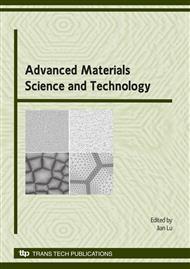[1]
A.B. Pandey, B.S. Majumdar, D.B. Miracle: Metallurgical and materials transactions. Vol. 29A (1998), pp.1237-1243.
Google Scholar
[2]
Robert Moskovic: Engineering fracture mechanics, Vol. 69 (2002), pp.511-530.
Google Scholar
[3]
T. Pardoen, Y. Marchal, F. Delannay: Engineering Fracture Mechanics, Vol. 69 (2002), pp.617-631.
DOI: 10.1016/s0013-7944(01)00099-6
Google Scholar
[4]
T. Pardoen, Y. Marchal, F. Delannay: J. Mech. Phys. Solids, Vol. 47 (1999), pp.2093-2123.
Google Scholar
[5]
Xiaozhi Hu, Kai Duan: Cement and Concrete Research, Vol. 34 (2004), pp.1321-1330.
Google Scholar
[6]
G.R. Odette, K. Edsinger G.E. Lucas, E. Donahue: ASTM STP 1329, Vol. 3(1998), p.298.
Google Scholar
[7]
B.P. Pehrson, J.D. Landes: Fatigue & Fracture of Engineering Materials & Structures, Vol. 30 (2007), pp.73-86.
Google Scholar
[8]
I.V. Orynyak, V.M. Torop: Engineering Fracture Mechanics, Vol. 52 (1995), pp.255-263.
Google Scholar
[9]
Bluhm JI: ASTM Proc, Vol. 61(1961), pp.1324-31.
Google Scholar
[10]
Y.L. Kang: Material science and engineer, Vol. 394A (2005), pp.312-139.
Google Scholar
[11]
Landes.J. D, McCabe.D. E: ASTM STP, Vol. 833 (1984), pp.378-392.
Google Scholar
[12]
D. Chae, D.A. Koss: Materials Science and Engineering, Vol. 366A (2004), pp.299-309.
Google Scholar
[13]
Thak Sang Byun, Seok Hun Kim, Bong Sang Lee, In Sup Kim: Journal of Nuclear Materials, Vol. 277 (2000), pp.263-273.
Google Scholar
[14]
Gurson: Journal of Engineering Material and Technology, Vol. 99 (1977), pp.2-15 Figures Specimen thickness Fracture toughness parameters B0 Bs -101234567.
Google Scholar
[5] [10] [15] [20] [25] [30] [35] Load (KN) CMOD(mm) 22mm 16mm 12mm 8mm 4mm Fig. 1 Fracture toughness VS specimen size schematically Fig. 2 Load/unload method Fig. 3 typical brittle fracture surface Fig. 4 typical ductile fracture surface -70 -60 -50 -40 -30 -20 -10 23. 5 24. 0 24. 5 25. 0 25. 5 26. 0 26. 5 Model: Boltzmann y = A2 + (A1-A2)/(1 + exp(x-x0)/dx) A1: 23. 80473(± 0. 08969) A2: 26. 03424(± 0. 10511) x0: -32. 76767(± 1. 00961) dx: 4. 15624(± 0. 91436) Fracture toughness J integral(KJ/m2) Temperature(o C) -80 -60 -40 -20 0 20.
DOI: 10.1111/j.1747-1567.1996.tb00475.x
Google Scholar
[28]
[30] [32] [34] [36] [38] [40] [42] Model: Boltzmann y = A2 + (A1-A2)/(1 + exp(x-x0)/dx) A1: 28. 57703(± 1. 51119) A2: 38. 88737(± 0. 96654) x0: -34. 43068(± 4. 58903) dx: 9. 50417(± 4. 95119) Fracture toughness J integral (KJ/m 2) Temperature( o C) Fig. 5 J versus Temperature (4mm) Fig. 6 J versus Temperature (8mm) -80 -60 -40 -20 0 20.
Google Scholar
[25]
[30] [35] [40] [45] [50] [55] Model: Boltzmann y = A2 + (A1-A2)/(1 + exp(x-x0)/dx) A1: 24. 96454(± 2. 45683) A2: 49. 62719(± 2. 25519) x0: -37. 08256(± 3. 25614) dx: 8. 53(± 3. 3152) Fracture toughness J integral (KJ/m2 ) Temperature( o C) -70-60-50-40-30-20-10.
Google Scholar
[20]
[30] [40] [50] [60] Model: Boltzmann y = A2 + (A1-A2)/(1 + exp(x-x0)/dx) A1: 22. 83142(± 1. 58537) A2: 54. 32069(± 0. 54431) x0: -55. 85876(± 0. 67396) dx: 3. 69983(± 0. 59356) Fracture toughnes J integral(KJ/m 2) Temperature(o C) Fig. 7 J versus Temperature (12mm) Fig. 8 J versus Temperature (16mm) -70 -60 -50 -40 -30 -20 -10.
Google Scholar
[20]
[25] [30] [35] [40] [45] [50] [55] Model: Boltzmann y = A2 + (A1-A2)/(1 + exp(x-x0)/dx) A1: 20. 09944(± 1. 997) A2: 45. 38342(± 0. 963) x0: -56. 6391(± 1. 008) dx: 2. 32058(± 0. 829) Fracture toughness J integral(KJ/m.
Google Scholar
[2]
) Temperature(o C).
Google Scholar
3 6 9 12 15 18 21 24.
Google Scholar
[14]
[21] [28] [35] [42] [49] [56] uppershelf lowershelf Fracture toughness J integral(KJ/m2) Thickness(mm) Fig. 9 J versus Temperature (22mm) Fig. 10 J versus thickness original crack tip current crack tip crack propagation path Fig. 11 typical brittle fracture surface.
DOI: 10.1017/cbo9780511623127.005
Google Scholar


